"A Great Treasure of Nevada"
August 12, 2009 - Primm, Nevada
At a yet another Bureau of Land management scoping meeting for the photovoltaic solar energy project proposed for more public lands in the Ivanpah Valley (>>map), we found ourselves agreeing with the OHV community who came to voice concern over the overlap of trails they have used on the large desert fan below the Lucy Grey Mountains.
The contractor hired by BLM to undertake the environmental review told the audience how the "great treasure" was insolation -- sunlight. (Not the beautiful Mojave Desert landscape.)
NextLight Renewable Power LLC, formed by New Jersey-based private equity firm Energy Capital Partners, a group of high-rolling Goldman-Sachs investors who buy and sell power generation plants, gas pipelines, dams, coal reserves (and perhaps soon carbon credits), is seeking to obtain a right-of-way permit to use 7,800 acres of Mojave desert on the large fan east of Primm, home to a rich yucca-creosote-galleta grass plant community, and full of federally threatened Desert tortoises (see our story on this >>here).
About 2,900 acres would have the actual panels. 21 acre-feet per year of water would be needed to wash dust from the panels.
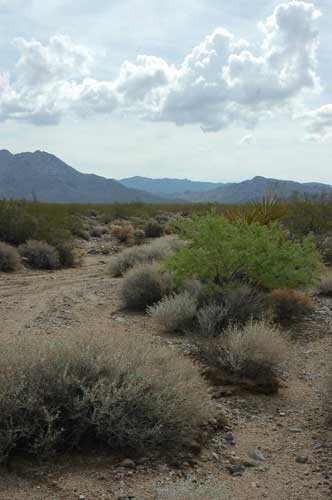
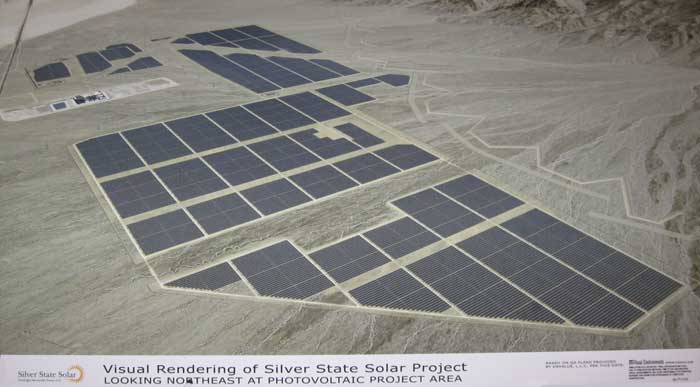
^Digital image of what the photovoltaic panel array would look like on the fan. The minute black square of Bighorn natural gas power plant is on the upper left, surrounded by panels.
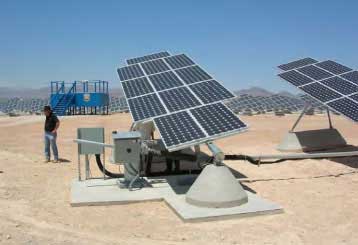
Photovoltaic pedestals proposed to cover thousands of acres of tortoise habitat on a fan. The Plan of Development says herbicides will be applied to the ground to keep weeds and fire fuels down.
MAP >>here.
OHV Recreation Area Conflict
The room had several off-road recreationists in the audience, and the first comment taken onto the record was from Las Vegas resident Ken Freeman who gave testimony that the large fan of Mojave desert scrub and washes was supposed to be a special management unit for OHV recreation, not for power plants. Three trails were permitted in the area up washes on the fan, and they would be blocked by the project.
BLM and NextLight say they are working with OHV groups to minimize the impacts this project has on staging areas and routes of travel. NextLight has approached BLM with various alternatives to maintain public access to the Lucy Greys and minimize impacts to the Jean/Roach Lake Special Recreation Management Area.
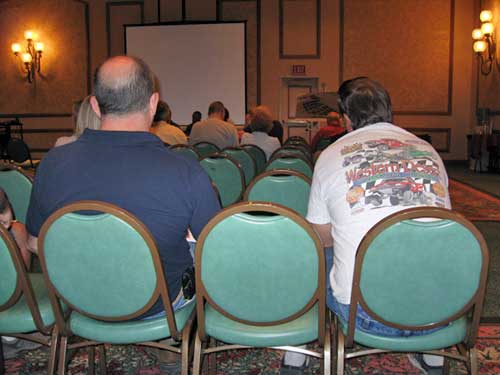
Freeman spoke about how he was concerned about loss of areas for off-road vehicles. The site is one of the few in southern Nevada approved for use by off-roaders. He also stated that “this is prime tortoise habitat,” and was concerned about the amount of land being taken. This plant should be built out of tortoise habitat, he said. "Build it IN Vegas, where people need the jobs, not outside."
The proposal site is also an area where four competitive off-road races take place annually, including the Terribles Primm 300.
Freeman also noted that the NextLight officials said they plan to wash the solar panels twice a year, but with off-road races nearby, they may find they will have to wash them more often. Eric Record, a fellow off-roader, said he thinks the company will try to coexist with off-roaders but find it too difficult.
“Once they get a taste of one or two events, they may not want to play nice anymore,” he said. “They may ask the BLM to stop the races.”
We found no OHV tracks off their trails on our ground survey of the site. The site appeared to be some of the densest tortoise habitat we have seen judging from the number of burrows, pallets (resting spots), bones, and scat.
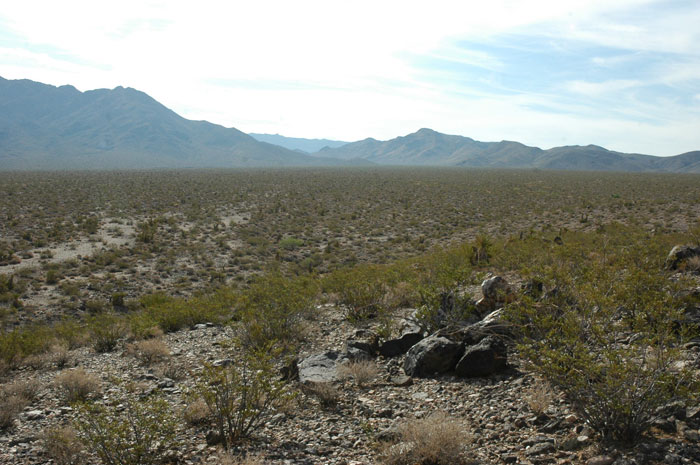
^The fan where a solar project is proposed. The Lucy Grey Mountains lie in the distance.
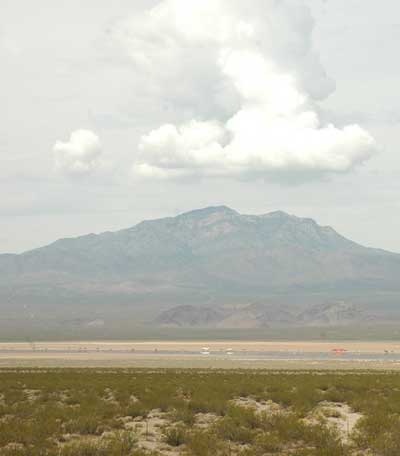
^Clark Mountain in Mojave National Preserve looms over Ivanpah Valley, as seen from the proposed NextLight Silver State 'South' project fan.

^Valley in danger. Looking northwards up the Ivanpah Valley along I-15 the highway, the proposed Ivanpah Solar Electric Generating System solar thermal project would eat up most of the west side (left) of the valley, while NextLight's photovoltaic power plant would take up the fan to the east, right of the playa. Other wind and solar projects are also planned for the vicinity.
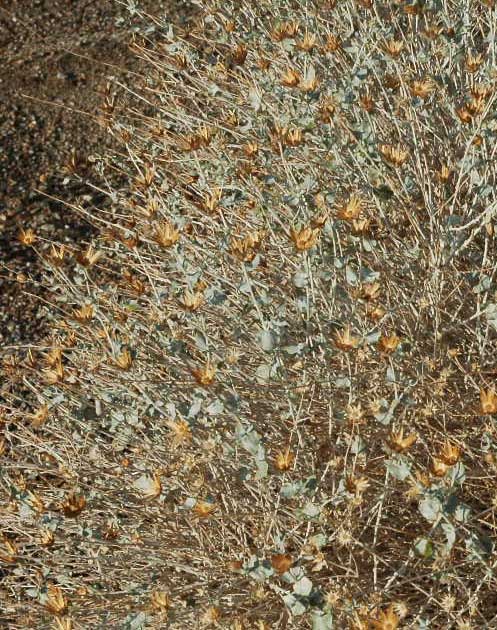
^Gray wash bricklebush (Brickelia incana).
Diverse Mojave Habitat
Another question asked was how many acres of vegetation would be scraped?
The answer was not clear. NextLight's experts could not say yet, as the exact model of photovoltaic panel had not yet been chosen. They said they would try to leave as much vegetation as possible, and undertake "micrograding."
The fan is high quality tortoise habitat, with abundant burrows and other sign, indicating a dense population. The substrate is crumbly granitic gravel and sand, with quartzite and metamorphic rock as well, perfect for tortoises to dig into.
More public commenters asked where all the tortoises would be moved to?
Ironically, BLM's Mark Chandler said their group had seen a tortoise on the northern edge of the project site just this morning. He said tortoise fencing would be placed around the site after all tortoises were removed. He also added that the U.S. Fish and Wildlife Service might decide that tortoises are too dense there and cannot be relocated. This will be decided after surveys are completed. "It can be mitigated," he seemed to plead.
Chandler also mentioned the Clark County Relocation area nearby. We were not sure if he implied that this would be the relocation area. Used for many years as a "dumping ground" for tortoises removed from the fast-growing Las Vegas metropolis during the housing boom, the site had been plagued by drought and tortoise die-offs, and over-crowding.
The area probably supports Gila monster, a State protected species, as well as Burrowing owl, which is a Federal Species of Concern.

^A burrow along a wash on the fan, used by tortoises and Desert woodrats. A tortoise thigh bone lies on the debris outside.
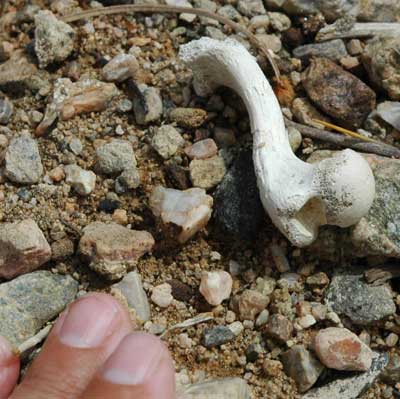
^The tortoise bone, apparently a femur.

^Calico cactus and Range rhatany on the project site.
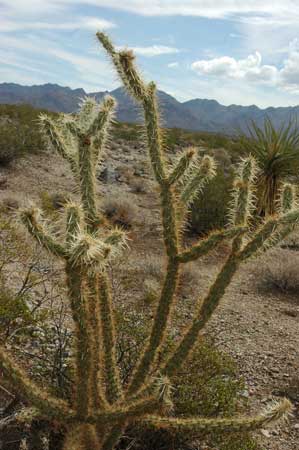
^Buckhorn cholla.
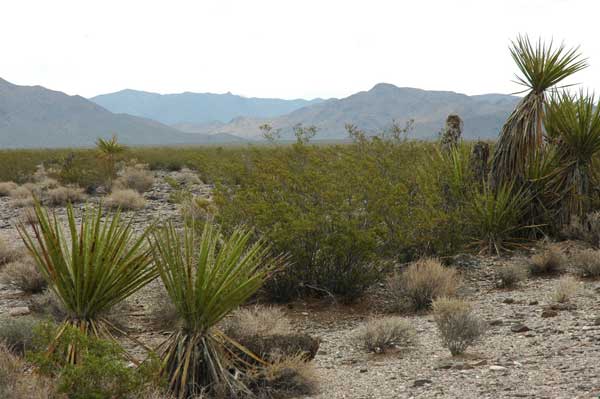
^The Lucy Grey Mountains in back of a rich Creosote-Bursage-yucca habitat.
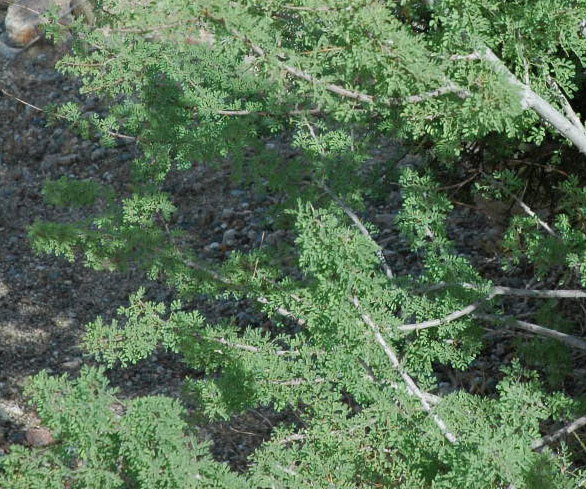
^Catclaw acacias are common in the washes here.
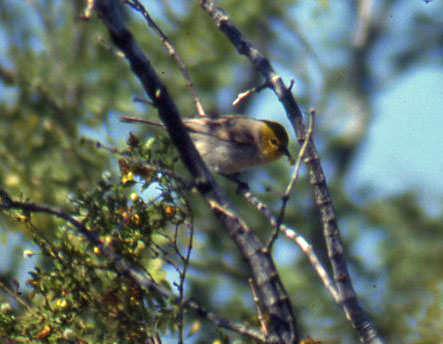
^Verdins, small desert birds, called in the acacias and creosote on our hike across the fan.

^Cactus wrens inhabited the chollas and yuccas on the fan site. We found a nest in a creosote.
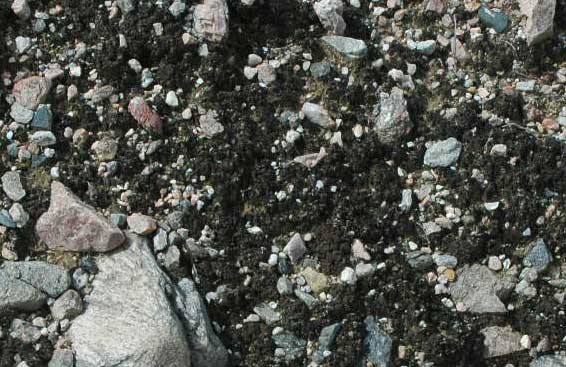
^The area is very little disturbed, and cryptobiotic crust is common: a living carbon-storing symbiotic algal-lichen layer in the soil.
Floodwater Diversions
On this excellent tortoise habitat, not only will buildings, paved roads, parking lots, gravel roads, a warehouse, photovoltaic modules, inverters, transformers, chain-link fences, and dust-control sprays on soils be used, but a large area of the fan will be managed for stormwater flood control. (See map >>here.)
A very large wash funnels flood waters from the higher, pinyon-juniper covered McCullough Range to the east, through a narrow canyon in the Lucy Gray Mountains, and onto the fan where the project will be built. In fact, the fan was made by flows over time from this canyon.
To prevent flash floods from this canyon damaging the solar project, NextLight has complex plans for a series of berms, ditches, debris basins and water detention ponds, spillways, and diversion channels to catch and move floodwater.
"Major earthwork is necessary due to the design constraints involved in constructing the solar trough arrays," says the Plan of Development Conceptual Drainage Study (p.5).

^Flash floods are regular in late summer on this fan. Looking west down the project site fan. The playa in the basin was full of water.
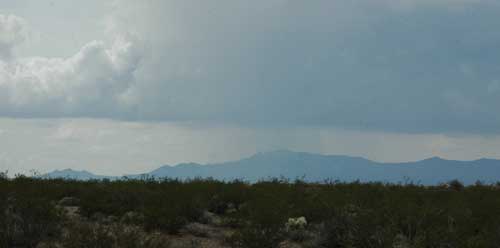
^Rain showers in the morning from summer monsoons.
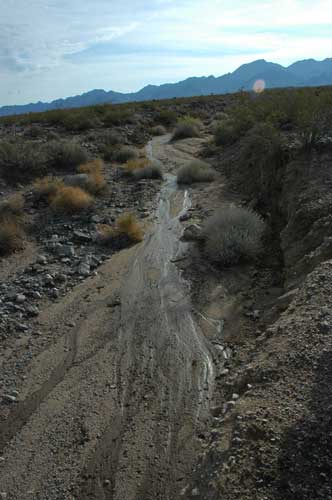
^Floodwaters from a small storm run down washes in the fan. What would a large flood do? We found old Pinyon pine cones in one wash, carried down from the distant mountains above.

^Flood control berms in digital image of what the Silver State South project would look like, to protect the photovoltaic panels from floodwaters pouring off the fan above. (From poster at the scoping meeting)
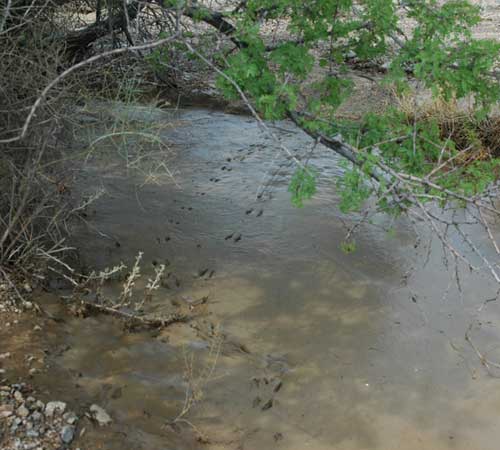
^Kangaroo rat (Dipodomys sp.) tracks hop across the wet mud of a wash, after a night of summer rain.
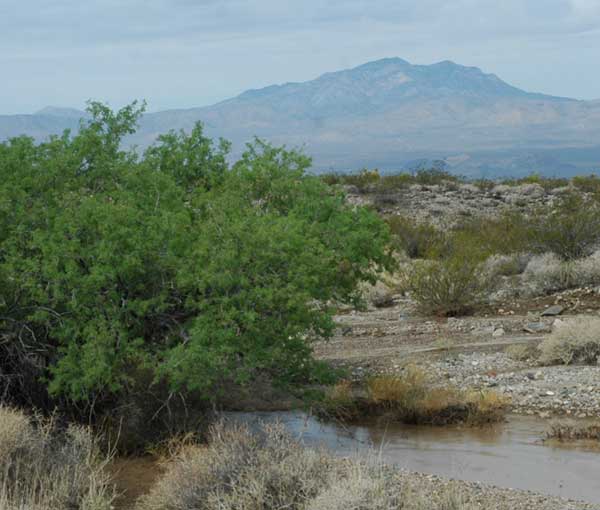
^Receding flash floodwaters in a wash with Catclaw acacia on the project site fan, with Clark Mountain in the distance.
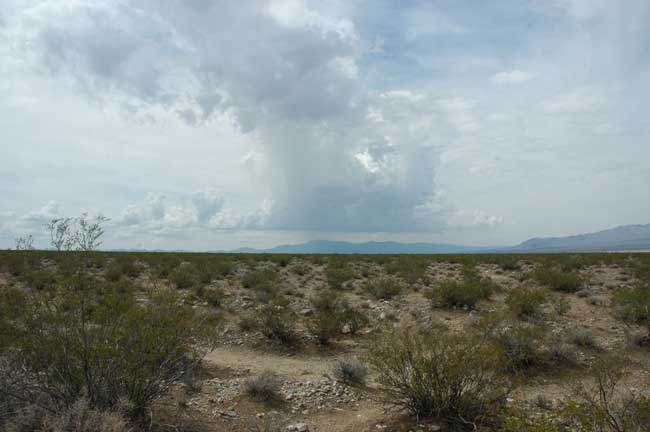
^A thunderhead with showers formed early this morning over mountains surrounding the site.
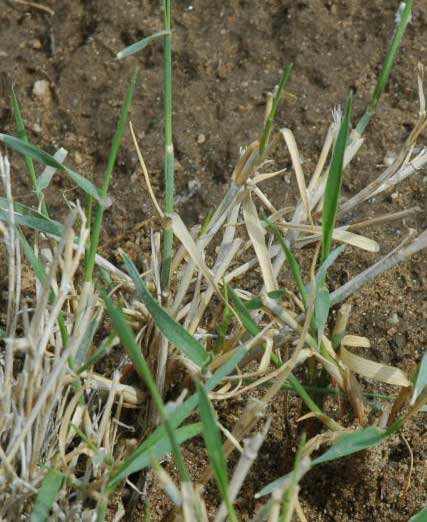
^New flush of leaves on Big galleta grass (Hilaria rigida) during August rains, very attractive food for adult tortoises.

^Pack rat (Neotoma lepida) tracks in the mud of a flooded wash.
Cumulative Impacts
Las Vegas BLM Renewable Energy Coordinator Greg Helseth explained how other projects in the area are faring. The Table Mountain wind project west of Primm is facing problems from the Federal Aviation Administration. It would conflict with air traffic control from the proposed Roach Lake airport in northern Ivanpah Valley. This new airport has long been in the works to expand service to Las vegas.
The McCullough Pass photovoltaic project by Cogentrix Energy LLC also seeks a large area of land.
Calculating the cumulative impacts was a "complicated process," Helseth noted.

^The casino stop Primm, with Table Mountain in the background, site of a proposed wind farm.

^Barrel cactus flower.

^The fan between the Lucy Gray Mountains and Ivanpah Dry Lake where NextLight proposes to build.
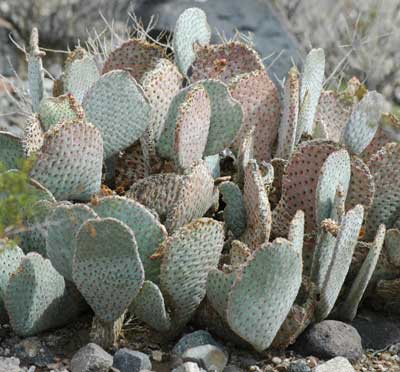
^Beavertail cactus on the site.

^Cottontop cactus on the fan site. The large canyon in the Lucy Gray Mountains that channels floodwaters is in the upper right. This scene will be destroyed for "renewable energy" if NextLight gets its permit from BLM.
See the story about the scoping meeting in the Las Vegas Sun >>here.

